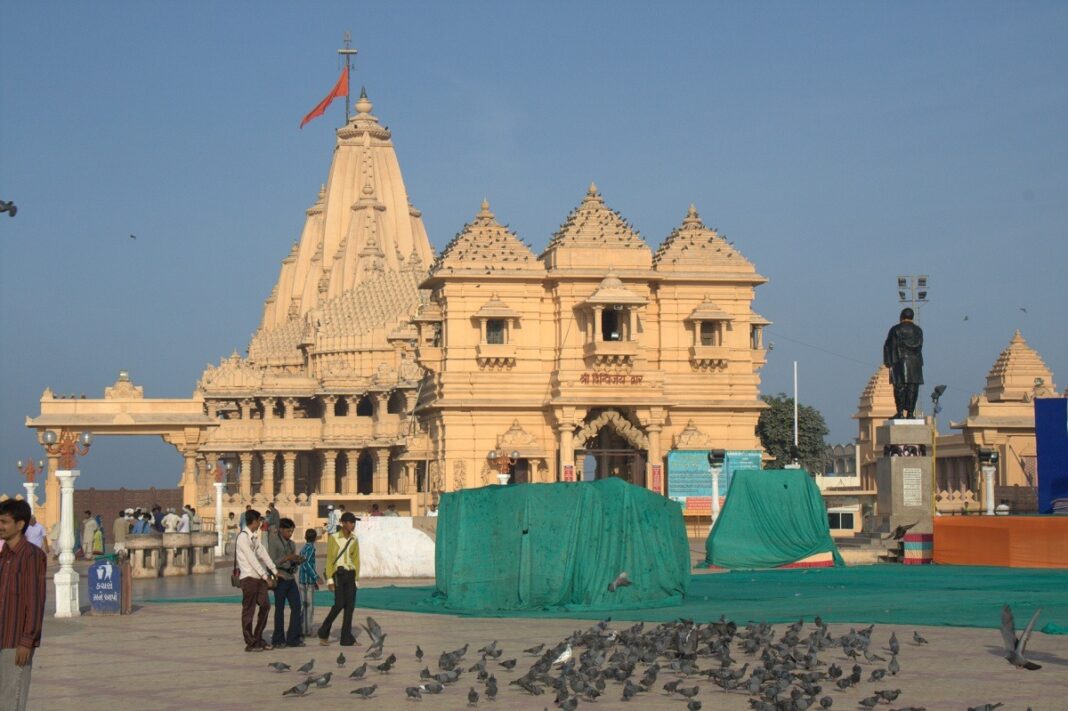INDIA. Lord Shiva is also known as The Destructor in Hindu mythology and is the Supreme God in Hinduism. For a Lord Shiva devotee, nothing is more divine than worshiping Lord Shiva at one of the twelve Jyotirlingas or visiting Kailash Parvat and Pashupati Nath temple and also trekking to Amarnath Cave.
A Jyotirlinga literally means a Radiant sign (phallus symbol) of almighty Mahadev and is a devotional representation of the lord Shiva. It is believed that there are 64 jyotirlingas, but only 12 of them are highly auspicious and holy. The 12 Jyotirlingas sites in India take the name of the presiding deity, each considered a different manifestation of Shiva.

The 12 Jyotirlingas in India are:
1. Somnath Jyotirlinga, in the Saurashtra region of Gujarat, is traditionally the first of the 12 Jyotirlingas, the Dwadash Jyotirlinga pilgrimage circuit. Rich in Chalukya style architecture, this temple features Lord Shiva in the form of a sizzling column of light.
2. Mallikarjuna Jyotirlinga is situated on the Shri Shaila Mountain, on the banks of the Krishna River in Andhra Pradesh. Mallikarjuna (Shiva) and Bhramaramba (Devi) are the presiding deities in the greatest Shaivite shrines in India, also known as the Kailash of the South.
3. Mahakaleshwar Jyotirlinga is located on the banks of the Kshipra River, in the dense Mahakal forest in Ujjain, MP. The Mahakaleshwar Temple is among one of the seven “Mukti-Sthal”, i.e. the place that can liberate a human. The Lingam at Mahakal is facing the south direction and is believed to be Swayambhu, the only one of the 12 Jyotirlingams to be so.
4. Omkareshwar Jyotirlinga is one of the highly revered Jyotirlinga and is located on an island, Shivapuri in the Narmada River in MP. Lord Shiva represents the Lord of Omkara here and is known as the Lord of the Om Sound.
5. Vaidyanath Jyotirlinga, also known as Vaijnath or Baidyanath Baba Dham is located at Deogarh in Jharkhand. Devotees believe that the sincere worship of this shrine relieves a person from all his worries and miseries.
6. Bhimashankar Jyotirlinga is located in the Sahyadri region of Pune, Maharashtra on the banks of Bhima River and is considered to be a source of this river. It’s a marvelous black rock structure, with Nagara architectural pattern.
7. Rameshwar Jyotirlinga is located on the island of Rameshwaram, Tamil Nadu. Rameshwaram Jyotirlinga is believed to have been worshipped by Lord Rama. This southernmost jyotirlinga in the country is surrounded by sea and has beautiful architecture. Popular as ‘Varanasi of the south’ this is also one among the Char Dhams of India.

8. Nageshwar Jyotirlinga, also known as Nagnath Temple is located between Gomati Dwarka and the Bhent Dwarka Island in Gujarat. This Jyotirlinga is believed to provide protection to the devotees from all types of poison.
9. Kashi Vishwanath is located in one of the most revered sites in the world- Kashi. It is situated amidst the crowded lanes of the holy city of Banaras (Varanasi) where a Hindu is expected to make a pilgrimage at least once in his life. The temple is home to the Vishwanath Jyotirlinga shrine, which is perhaps the most sacred of Hindu shrines.
10. Trimbakeshwar, located near Nasik in Maharashtra is a Jyotirlinga shrine associated with the origin of the Godavari River. The jyotirlinga here has a unique shape with a void, which has three pillars placed inside. The three pillars represent three most powerful and authoritative Gods, namely, Brahma, Vishnu, and Mahesh.
11. Kedarnath Jyotirlinga in Uttarakhand is one of the holiest pilgrimage sites in India, located on Mt Kedar in the Rudra Himalaya Range at the height of 12000 feet. For offering prayers at the Kedarnath Temple, devotees have to take great pains to trek into treacherous hilly terrains, but they still reach the temple in big numbers.

12. Ghrishneshwar Jyotirlinga is located in a village called Verul, near Aurangabad, Maharashtra by the caves of Ajanta and Ellora. It is also known by various other names like Ghushmeswara, Kusumeswarar, Grishneswara, and Grushmeswara.
Other Important Lord Shiva Pilgrim Centers:
In addition to the above 12 Jyotirlingas, three other Lord Shiva pilgrim centers are a must visit for every Shaivite.

Sadhus outside a Shiva Temple 
Pashupati Nath Temple in Nepal
Pashupati Nath Temple in Kathmandu, Nepal is a famous and sacred Hindu temple complex on the banks of Bagmati River. The temple, built in 400 B.C., has a richly ornamented pagoda that houses the sacred Shiva lingam. The linga at Pashupatinath is Lord Shiva’s head whereas the jyotirlingas in India are Shiva’s body and the linga.
A large number of peaks and ranges in the Great Himalayas are named after Lord Shiva. The most famed among these is Mount Kailash (22028 feet, 6714 meters), and on top is the heavenly abode of Lord Shiva. The pilgrimage to Kailash and Manasarovar is considered to be one of the most difficult in Asia.

Shravan is also the month when one can go for the annual Amarnath yatra. For every devotee of Bholey Baba, Amarnath yatra is a must. This is a very difficult pilgrimage as one has to trek for 4 days through the traditional route to reach the cave.






Comments are closed.